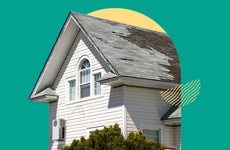Homeowners insurance statistics and facts

The Bankrate promise
At Bankrate, we strive to help you make smarter financial decisions. To help readers understand how insurance affects their finances, we have licensed insurance professionals on staff who have spent a combined 47 years in the auto, home and life insurance industries. While we adhere to strict , this post may contain references to products from our partners. Here's an explanation of . Our content is backed by Coverage.com, LLC, a licensed entity (NPN: 19966249). For more information, please see our .
If you own a home, it’s important to consider investing in homeowners insurance. A comprehensive home insurance policy provides valuable protection for your finances if your home and personal belongings are damaged or destroyed due to a covered loss like a fire, home break-in or severe storm. As of 2023, data show that 88 percent of homeowners have an active homeowners insurance policy.
While home insurance is not legally required (unlike auto insurance), many mortgage lenders require customers to obtain coverage. The cost of home insurance is dependent on a variety of personal factors like your location, the cost to rebuild your home and your claims history. Getting quotes from multiple home insurance providers can help you find the cheapest policy for your situation.
The latest statistics on homeowners insurance claims
Homeowners insurance claim statistics tell a compelling story about the importance of home insurance in the United States. Data also highlight the many factors that influence the type and frequency of claims in different parts of the country.
- According to a study, 5.3% of all insured homes had a claim in 2021. (Insurance Information Institute [Triple-I])
- Only about 47% of homeowners said they prepared an inventory of their personal belongings to help document losses, according to a 2023 report. (Triple-I)
- Bankrate’s 2023 Extreme Weather Survey indicated that 57% of U.S. adults have incurred costs from extreme weather over the past decade, with a pronounced impact in the Southern U.S., where 63% of residents reported such expenses. (Bankrate)
- Between 2017 and 2021, the average property damage claim payout was $15,091. Fire and lightning claims had the highest average payout, which was $83,519. (Triple-I)
- 57% of Americans believe that the climate, extreme weather and the environment will negatively affect their finances in the next 10 years, according to Bankrate’s 2023 Extreme Weather Survey. (Bankrate)
- While liability insurance claims are rare (making up just 2.3% of all homeowners insurance claims), they often have higher payouts than property damage claims. Between 2017 and 2021, the average liability insurance claim payout was $25,323. (Triple-I)
What are the most common causes of homeowners insurance claims?
Property damage claims are the most common type of home insurance loss. In 2021 (the most recent data available), wind and hail claims were the most common, followed by fire and lightning claims. Theft is consistently the least common type of property damage claim. However, the main causes of property loss have fluctuated over the last several years. In the table below, you can see the percentage of various property claims between 2017 and 2021.
| Cause of property loss | 2017 | 2018 | 2019 | 2020 | 2021 |
|---|---|---|---|---|---|
| Wind and hail | 48.0% | 39.5% | 38.3% | 47.8% | 39.4% |
| Fire and lightning | 26.2% | 26.0% | 21.5% | 21.9% | 24.8% |
| Water damage and freezing | 18.0% | 24.5% | 29.0% | 19.9% | 23.5% |
| Theft | 1.0% | 1.0% | 1.0% | 0.6% | 0.7% |
| All other property damage | 4.6% | 6.5% | 7.1% | 7.4% | 9.4% |
Source: Triple-I
Home insurance statistics state by state
The average cost of home insurance in the U.S. is $2,151 per year for $300,000 in dwelling coverage, but the rate you pay could be higher or lower based on your location and other factors.
For example, homeowners in Southern states generally pay higher rates due to the increased risk of severe weather. On the other hand, homeowners who live on the West Coast often pay lower rates because weather-related property damage claims are less likely. In the table below, you can see the average home insurance cost in all 50 states and Washington, D.C., based on information Bankrate analyzed from Quadrant Information Services.
-
State Average annual premium for $300,000 in dwelling coverage Alabama $2,969 Alaska $1,189 Arizona $2,070 Arkansas $3,019 California $1,403 Colorado $2,988 Connecticut $1,657 Delaware $1,026 Florida $5,770 Georgia $2,057 Hawaii $1,146 Idaho $1,201 Illinois $2,079 Indiana $1,647 Iowa $1,881 Kansas $3,914 Kentucky $2,603 Louisiana $5,710 Maine $1,154 Maryland $1,599 Massachusetts $1,606 Michigan $1,796 Minnesota $2,527 Mississippi $4,289 Missouri $2,099 Montana $2,311 Nebraska $5,121 Nevada $1,257 New Hampshire $941 New Jersey $1,102 New Mexico $2,405 New York $1,710 North Carolina $2,535 North Dakota $2,475 Ohio $1,460 Oklahoma $4,675 Oregon $1,050 Pennsylvania $1,144 Rhode Island $1,983 South Carolina $2,320 South Dakota $2,529 Tennessee $2,395 Texas $4,039 Utah $1,117 Vermont $799 Virginia $1,391 Washington $1,316 Washington, D.C. $1,327 West Virginia $1,328 Wisconsin $1,145 Wyoming $1,352
Most expensive states for home insurance
Not surprisingly, homeowners located in parts of the country that experience strong tropical storms, hurricanes and tornadoes commonly face some of the highest property insurance premiums. Based on homeowner insurance statistics, homeowners in Florida pay the highest rates for insurance in the country. In the table below, you can see the most expensive states for home insurance and the average annual premium.
| State | Average annual premium for $300,000 in dwelling coverage |
|---|---|
| Florida | $5,770 |
| Louisiana | $5,710 |
| Nebraska | $5,121 |
| Oklahoma | $4,675 |
| Mississippi | $4,289 |
Least expensive states for home insurance
As one might expect, states that do not experience a high number of damaging weather events typically see more affordable home insurance. Many states have average rates below the national average premium, which is $2,151 per year. The table below highlights the cheapest states for home insurance and the average annual rate.
| State | Average annual premium for $300,000 in dwelling coverage |
|---|---|
| Vermont | $799 |
| New Hampshire | $941 |
| Delaware | $1,026 |
| Oregon | $1,050 |
| New Jersey | $1,102 |
Note that none of these five states have historically experienced catastrophic weather events on a regular basis. However, there are many factors that impact home insurance premiums and conditions that can affect whether a rate will be higher or lower than the national average, even within the same state.
Similarly, premiums can vary significantly by ZIP code depending on crime patterns. Not only will your home insurance rates likely increase following a burglary to your own dwelling, but you may also pay higher rates if other homeowners in your neighborhood experience higher than normal rates of property crime.
Home insurance industry trends
The home insurance industry continues to evolve significantly under the pressure of economic fluctuations and escalating climate-related risks. Among the most impactful factors are the challenges faced in states like Florida and California, where the risk of natural disasters has led to substantial changes in the insurance landscape.
In Florida, a combination of high litigation costs and an increased frequency of severe storms has compelled many insurance companies to withdraw from the state. Heavily impacted by lawsuits, insurance companies like United Insurance Holdings Corp. (UPC), Southern Fidelity and Weston Property & Casualty have pulled out or gone into liquidation. These departures have left homeowners scrambling for coverage amid skyrocketing premiums.
In California, similar challenges are emerging, largely due to the state’s severe wildfire risk. In recent years, heightened wildfire activity and rising construction costs have pushed major insurers like State Farm, Allstate and Farmers to limit new homeowner policies. The situation is exacerbated by Proposition 103, which restricts how much insurers can raise rates, further complicating their ability to adjust to increasing risks.
Despite the retreat of some insurers from high-risk states, new companies have stepped in to fill the void. In Florida, recent approvals for six new companies to take on policies from the state-run Citizens Insurance indicate a dynamic shift, suggesting that while the market faces difficulties, it also offers opportunities for new entrants. Meanwhile, in California, adjustments are being considered to allow insurers to use modern wildfire risk models to set rates, which could entice insurers to return or expand their offerings in the state.
The challenges in the home insurance markets of California and Florida are indicative of broader trends that could reshape the national landscape of property insurance. As major insurers recalibrate their strategies to manage risks associated with climate change and regulatory environments, other states could experience similar shifts. This could lead to an increase in market volatility, with potential spikes in premiums and shifts in policy availability across the U.S.
Additionally, the responses from state governments and insurers in California and Florida could serve as models for other regions facing similar issues, possibly leading to significant changes in national insurance regulation and market practices. As these states navigate their unique challenges, their experiences may well set precedents for how insurers and policymakers nationwide approach the growing risks associated with natural disasters and economic shifts in the home insurance sector.
Average homeowners insurance cost by company
Although home insurance premiums are largely based on personal factors, rates will also depend on your home insurance company. Average rate data show that some home insurance providers have lower rates than other insurers. This is why it’s important to get quotes from multiple companies before choosing a provider. Below, you can see the average cost of home insurance from some of the biggest and most reputable carriers in the industry.
| Insurance company | Avg. annual premium |
|---|---|
| State Farm | $1,774 |
| Allstate | $2,326 |
| USAA | $1,442 |
| Farmers | $2,525 |
| Travelers | $2,092 |
| American Family | $1,662 |
| Nationwide | $1,813 |
| Chubb | $3,578 |
| Erie Insurance | $1,633 |
| Auto-Owners | $1,410 |
Of course, the actual premiums for any home insurance policy can vary significantly from these averages based on myriad factors. On the plus side, various discounts may be available depending on individual circumstances and the company you choose.
Frequently asked questions
-
-
The length of time it takes for a home insurance claim to be paid can vary significantly depending on several factors, including the complexity of the claim, the amount of damage and the specific requirements of the insurance policy. Generally, insurers in many states are required to pay out claims within a “reasonable” time frame, which can be anywhere from a few days to several weeks. However, more complex or costly claims can take longer to process, sometimes extending to months.
For instance, some states like Minnesota and Texas have specific regulations that require insurance companies to pay out accepted claims within five days, while other states like Florida allow up to 60 days. However, in states without specific timelines, insurance companies are expected to handle claims in a reasonable period, often defined by state law as 30 to 45 days to acknowledge a claim and up to 40 days to approve or deny it after receipt of proof of loss.
-
According to statistics from the Triple-I, about 5.3 percent of homeowners filed an insurance claim in 2021. This rate indicates that while the majority of homeowners may not need to file a claim in any given year, a significant number still do, reflecting the various risks and unforeseen events that homeowners can face, such as property damage from weather, theft or other accidents.
-
Based on homeowners’ incurred losses by state data provided by the Insurance Information Institute, California typically sees the highest amount of home insurance claims in terms of monetary losses, totaling almost $16 million. This figure suggests that California might experience a higher frequency or severity of events that lead to insurance claims, possibly due to its susceptibility to wildfires, earthquakes and other natural disasters.
-
The percentage of home insurance claims that are denied can vary widely depending on several factors including the type of claim, the insurance provider and specific policy details. Generally, some claims might be denied due to reasons like non-payment of premiums, filing a claim for something not covered by the policy or discrepancies in the claim details. It’s important for homeowners to thoroughly understand their insurance policy and ensure all information is accurate when filing a claim. This can help reduce the likelihood of a claim being denied. If a claim is denied, homeowners typically have the right to ask for a detailed explanation and may have the option to appeal the decision.
-
Methodology
Bankrate utilizes Quadrant Information Services to analyze April 2024 rates for all ZIP codes and carriers in all 50 states and Washington, D.C. Quoted rates are based on married male and female homeowners with a clean claim history, good credit and the following coverage limits:
- Coverage A, Dwelling: $300,000
- Coverage B, Other Structures: $30,000
- Coverage C, Personal Property: $150,000
- Coverage D, Loss of Use: $60,000
- Coverage E, Liability: $500,000
- Coverage F, Medical Payments: $1,000
The homeowners also have a $1,000 deductible, a $500 hail deductible and a 2 percent hurricane deductible (or the next closest deductible amounts that are available) where separate deductibles apply.
These are sample rates and should be used for comparative purposes only. Your quotes will differ.
Related Articles



